南方医科大学学报 ›› 2025, Vol. 45 ›› Issue (5): 977-985.doi: 10.12122/j.issn.1673-4254.2025.05.10
卞芬兰1,3( ), 倪诗垚2,3, 赵鹏1,3, 戚毛男星1,3, 唐碧1, 王洪巨1, 康品方1,3(
), 倪诗垚2,3, 赵鹏1,3, 戚毛男星1,3, 唐碧1, 王洪巨1, 康品方1,3( ), 刘进军1,3(
), 刘进军1,3( )
)
收稿日期:2024-11-18
出版日期:2025-05-20
发布日期:2025-05-23
通讯作者:
康品方,刘进军
E-mail:1174672677@qq.com;kangpinfang.1016@163.com;ljj19740828101@163.com
作者简介:卞芬兰,在读硕士研究生,E-mail: 1174672677@qq.com
基金资助:
Fenlan BIAN1,3( ), Shiyao NI2,3, Peng ZHAO1,3, Maonanxing QI1,3, Bi TANG1, Hongju WANG1, Pinfang KANG1,3(
), Shiyao NI2,3, Peng ZHAO1,3, Maonanxing QI1,3, Bi TANG1, Hongju WANG1, Pinfang KANG1,3( ), Jinjun LIU1,3(
), Jinjun LIU1,3( )
)
Received:2024-11-18
Online:2025-05-20
Published:2025-05-23
Contact:
Pinfang KANG, Jinjun LIU
E-mail:1174672677@qq.com;kangpinfang.1016@163.com;ljj19740828101@163.com
Supported by:摘要:
目的 探讨积雪草苷(AS)在保护大鼠心肌缺血再灌注损伤(MIRI)中的保护机制。 方法 将50只SD大鼠随机分为假手术组(sham)、模型组(I/R)、AS处理组。AS处理组在手术前连续2周灌胃,根据给予不同剂量的AS分为低剂量组、中剂量组、高剂量组, 10只/组。检测血清中的乳酸脱氢酶(LDH)、肌酸激酶同工酶(CK-MB)、白介素-18(IL-18)和白介素-1β(IL-1β)浓度,测量各组大鼠心肌梗死和缺血范围,并观察心肌组织的病理变化。使用Western blotting法检测心肌组织中NLRP3、ASC、caspase-1、GSDMD、GSDMD-N、IL-1β和IL-18的蛋白含量。此外,通过缺氧复氧(H/R)实验在H9C2细胞中模拟缺血再灌注损伤,并进行AS预处理。 结果 与sham组相比,I/R组心肌梗死和缺血范围增加,血清中LDH和CK-MB水平升高,心肌组织中NLRP3、ASC、caspase-1、GSDMD、GSDMD-N、IL-1β和IL-18蛋白含量升高(P<0.05)。与I/R组相比,AS处理组的心肌梗死范围、血清LDH和CK-MB水平降低,心肌组织中上述蛋白含量也降低(P<0.05),且AS的保护作用呈剂量依赖性。体外实验显示,H/R处理导致NLRP3、ASC、caspase-1、GSDMD、GSDMD-N、IL-1β和IL-18蛋白表达增加(P<0.05),而AS预处理可减轻H/R损伤(P<0.05)。分子对接结果表明,AS与NLRP3具有良好的结合活性。 结论 积雪草苷可以减轻大鼠心肌再灌注损伤,其机制可能通过抑制NLRP3炎症体介导的细胞焦亡实现。
卞芬兰, 倪诗垚, 赵鹏, 戚毛男星, 唐碧, 王洪巨, 康品方, 刘进军. 积雪草苷通过抑制NLRP3炎症体介导的细胞焦亡减轻大鼠心肌缺血再灌注损伤[J]. 南方医科大学学报, 2025, 45(5): 977-985.
Fenlan BIAN, Shiyao NI, Peng ZHAO, Maonanxing QI, Bi TANG, Hongju WANG, Pinfang KANG, Jinjun LIU. Asiaticoside alleviates myocardial ischemia-reperfusion injury in rats by inhibiting NLRP3 inflammasome-mediated pyroptosis[J]. Journal of Southern Medical University, 2025, 45(5): 977-985.
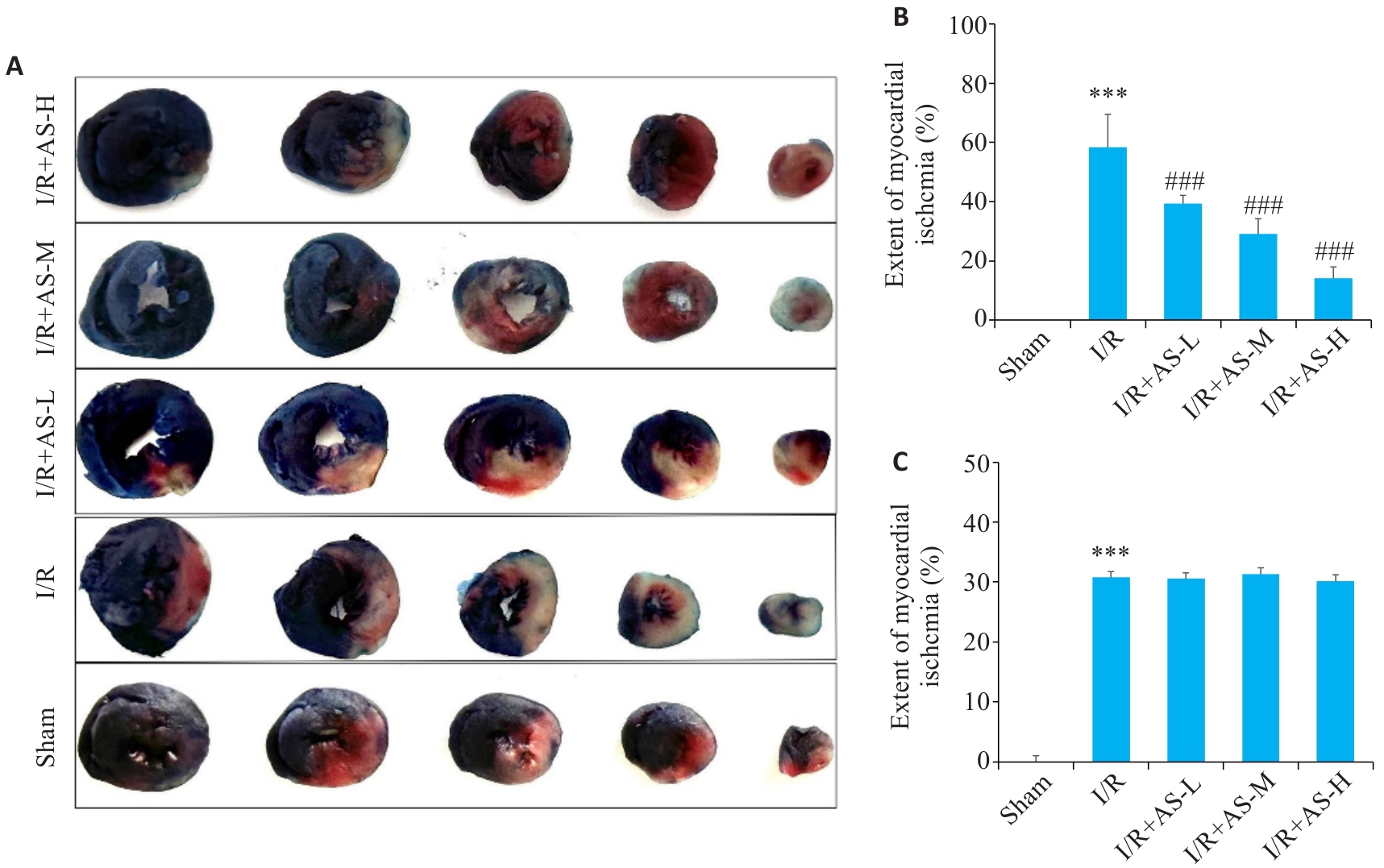
图2 各组大鼠心脏TTC-Evansblue染色结果
Fig.2 TTC-Evans blue staining of rat cardiac tissues (A) and comparison of the extent of myocardial infarction (B) and ischemia (C) among the 5 groups. ***P<0.001 vs Sham group; ###P<0.001 vs I/R group (Mean±SD, n=3).
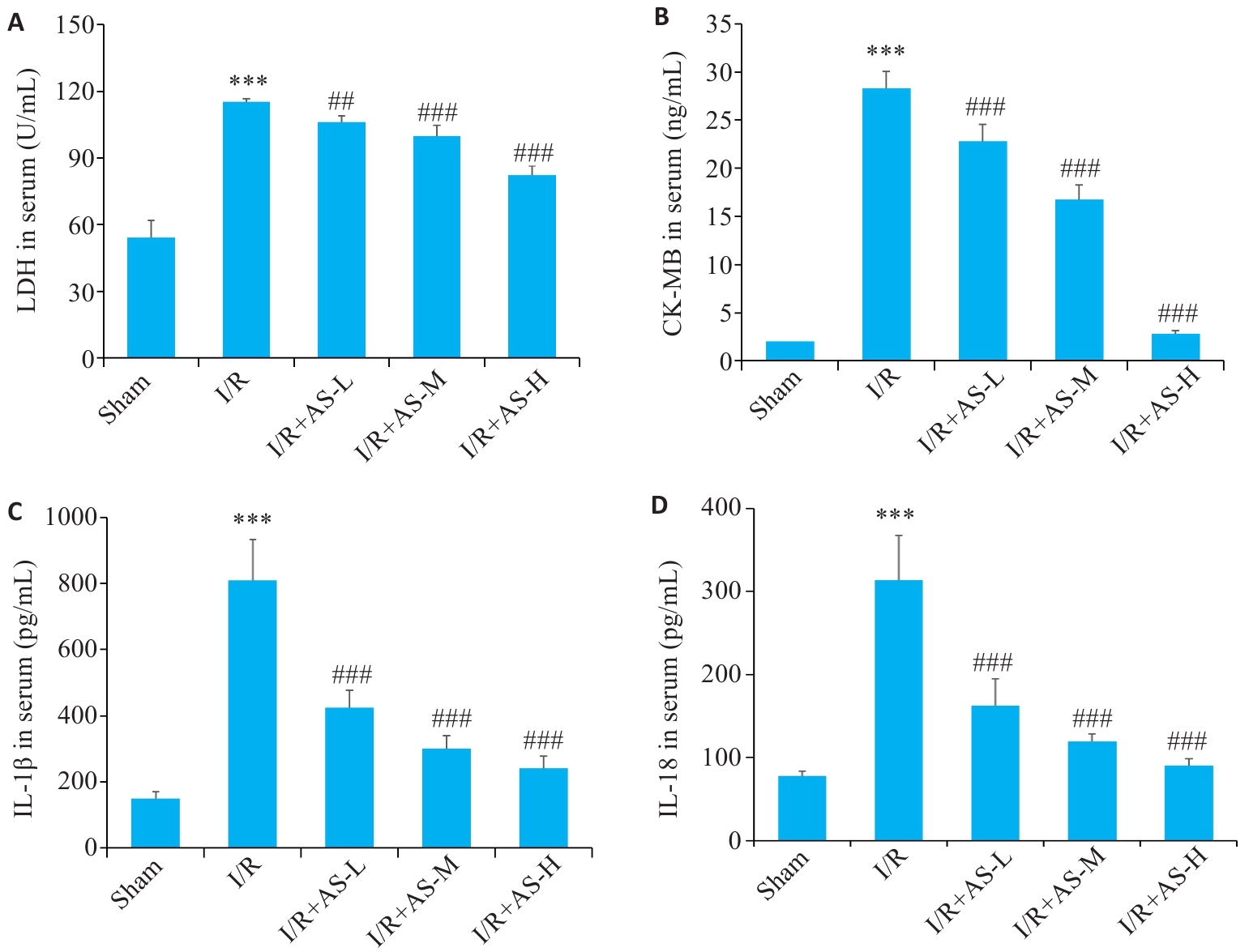
图3 AS对MIRI大鼠血清中LDH、CK-MB、IL-1β、IL-18的影响
Fig.3 Effect of AS pretreatment on serum levels of LDH (A), CK-MB (B), IL-1β (C) and IL-18 (D) in MIRI rats. ***P<0.001 vs Sham group; ##P<0.01, ###P<0.001 vs I/R group (Mean±SD, n=6).
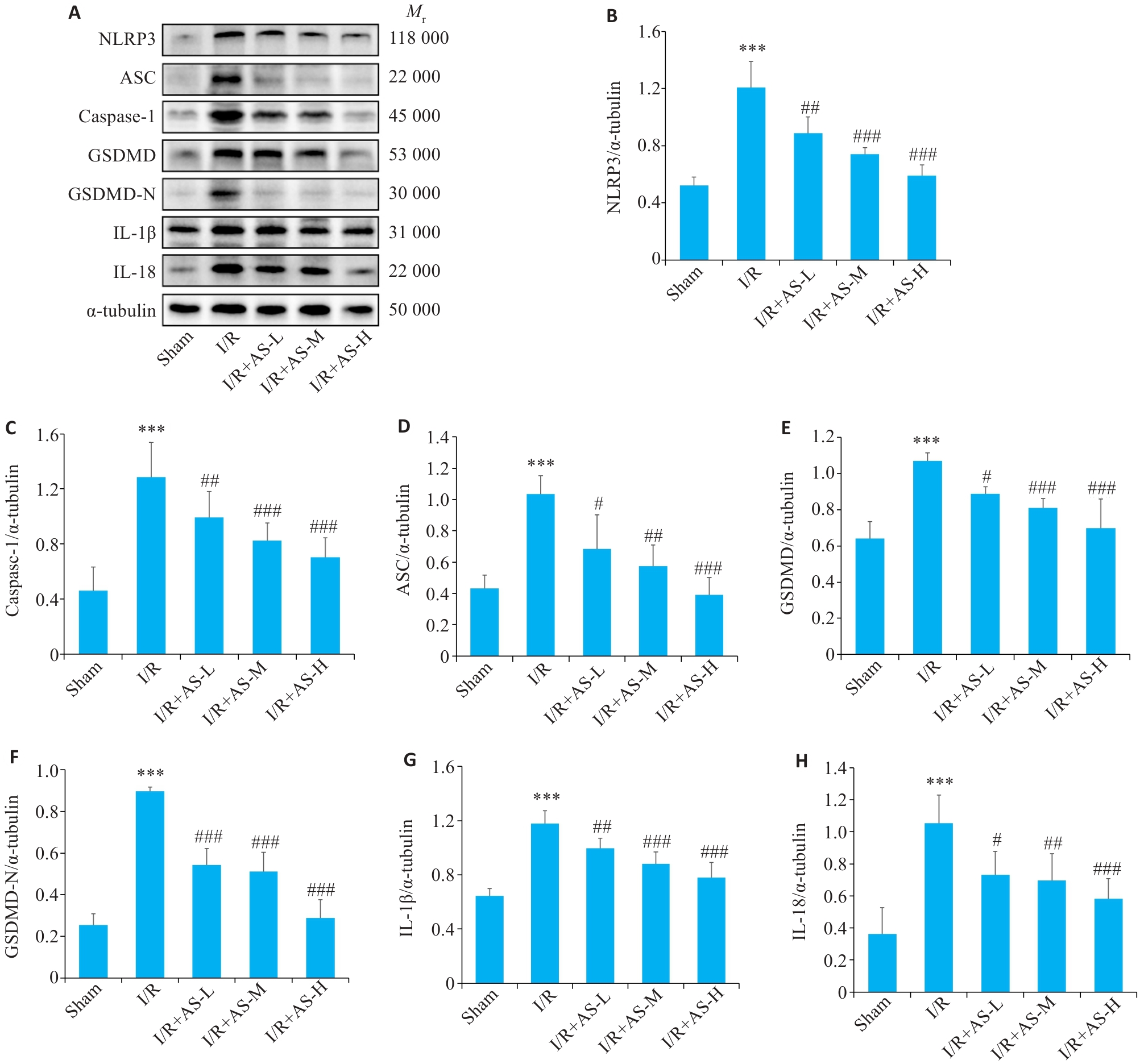
图5 Western blotting 检测各组大鼠心肌组织中的蛋白表达情况
Fig.5 Western blotting for detecting protein expressions in the myocardial tissue of the rats in each group. A: Western blots of NLRP3, caspase-1, ASC, GSDMD, GSDMD-N, IL-1β and IL-18 in the myocardial tissues of the rats. B-H: Quantitative analysis of pyroptosis-related proteins in each group. ***P<0.001 vs Sham group; #P<0.05, ##P<0.01, ###P<0.001 vs I/R group (Mean±SD, n=4).
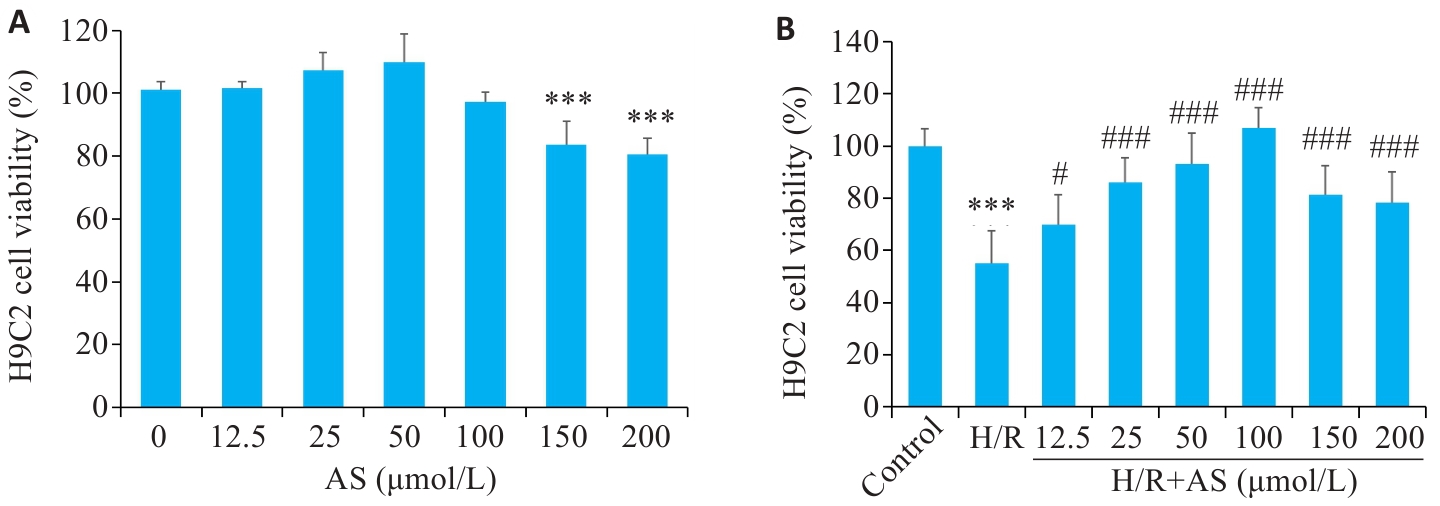
图6 不同浓度AS对H9C2细胞活力的影响
Fig.6 Effects of different concentrations of AS on viability of H9C2 cells. A: Effect of AS on viability of H9C2 cells. B: Effect of AS pretreatment on viability of H9C2 cells with hypoxia-reoxygenation injury. ***P<0.001 vs Control group; #P<0.05,###P<0.001 vs H/R group (Mean±SD, n=3).

图7 各组H9C2细胞中NLRP3、caspase-1蛋白表达
Fig.7 Immunofluorescence staining showing NLRP3 and caspase-1 protein expressions in H9C2 cells in each group. A: Immunofluorescence staining of NLRP3 in H9C2 cells in each group (Original magnification: ×20). B: Immunofluorescence staining of caspase-1 in H9C2 cells in each group (×20). C: Average fluorescence intensity of NLRP3 in each group. D: Average fluorescence intensity of caspase-1 in each group. ***P<0.001 vs Control group; ###P<0.001 vs H/R group (Mean±SD, n=3).
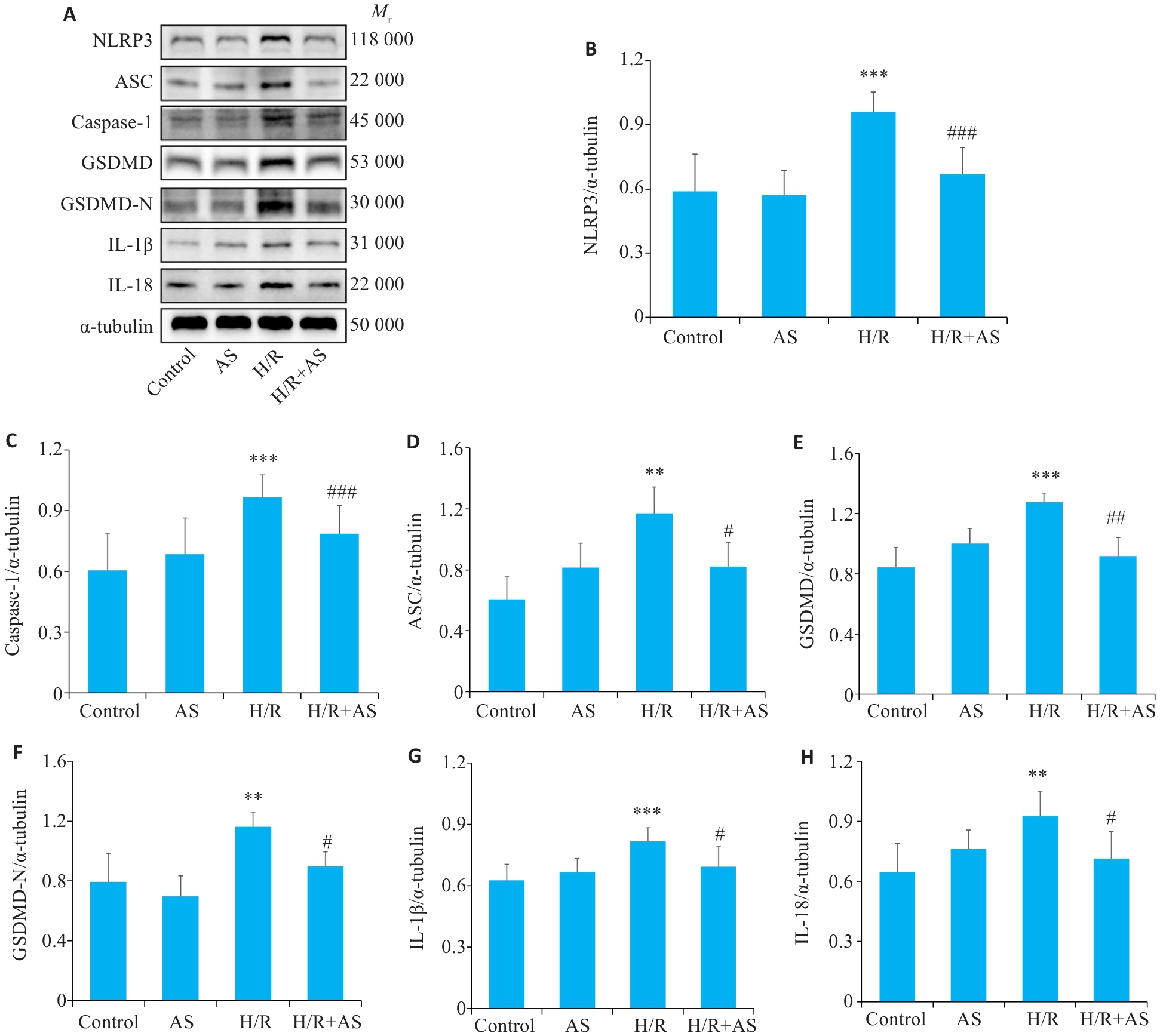
图8 Western blotting 检测各组H9C2细胞中蛋白表达情况
Fig.8 Western blotting for detecting protein expressions in H9C2 cells in each group. A: Western blots of NLRP3, caspase-1, ASC, GSDMD, GSDMD-N, IL-1β and IL-18 in H9C2 cells in each group. B-H: Quantitative analysis of expressions of the pyroptosis-related proteins in H9C2 cells in each group. **P<0.01,***P<0.001 vs Control group; #P<0.05, ##P<0.01, ###P<0.001 vs H/R group (Mean±SD, n=4).
| 1 | Benjamin EJ, Muntner P, Alonso A, et al. Heart disease and stroke statistics-2019 update: a report from the American heart association[J]. Circulation, 2019, 139(10): e56-528. |
| 2 | Tibaut M, Mekis D, Petrovic D. Pathophysiology of myocardial infarction and acute management strategies[J]. Cardiovasc Hematol Agents Med Chem, 2017, 14(3): 150-9. |
| 3 | Dauerman HL, Ibanez B. The edge of time in acute myocardial infarction[J]. J Am Coll Cardiol, 2021, 77(15): 1871-4. |
| 4 | Thuny F, Lairez O, Roubille F, et al. Post-conditioning reduces infarct size and edema in patients with ST-segment elevation myocardial infarction[J]. J Am Coll Cardiol, 2012, 59(24): 2175-81. |
| 5 | Larose E, Rodés-Cabau J, Pibarot P, et al. Predicting late myocardial recovery and outcomes in the early hours of ST-segment elevation myocardial infarction traditional measures compared with microvascular obstruction, salvaged myocardium, and necrosis characteristics by cardiovascular magnetic resonance[J]. J Am Coll Cardiol, 2010, 55(22): 2459-69. |
| 6 | Toldo S, Mauro AG, Cutter Z, et al. Inflammasome, pyroptosis, and cytokines in myocardial ischemia-reperfusion injury[J]. Am J Physiol Heart Circ Physiol, 2018, 315(6): H1553-68. |
| 7 | Zeng ZL, Li GH, Wu SY, et al. Role of pyroptosis in cardiovascular disease[J]. Cell Prolif, 2019, 52(2): e12563. |
| 8 | Zhang J, Huang L, Shi X, et al. Metformin protects against myocardial ischemia-reperfusion injury and cell pyroptosis via AMPK/NLRP3 inflammasome pathway[J]. Aging: Albany NY, 2020, 12(23): 24270-87. |
| 9 | Liu S, Bi Y, Han T, et al. The E3 ubiquitin ligase MARCH2 protects against myocardial ischemia-reperfusion injury through inhibiting pyroptosis via negative regulation of PGAM5/MAVS/NLRP3 axis[J]. Cell Discov, 2024, 10(1): 24. |
| 10 | SWANSON K V, DENG M, TING J P. The NLRP3 inflammasome: molecular activation and regulation to therapeutics [J]. Nat Rev Immunol, 2019, 19(8): 477-89. |
| 11 | Bandopadhyay S, Mandal S, Ghorai M, et al. Therapeutic properties and pharmacological activities of asiaticoside and madecassoside: a review[J]. J Cell Mol Med, 2023, 27(5): 593-608. |
| 12 | 阳 飞, 黄 辉, 王 芳, 等. 积雪草苷对大鼠心肌缺血再灌注损伤的保护作用以及MAPK通路的影响[J]. 中国医院药学杂志, 2021, 41(15): 1514-8. DOI: 10.13286/j.1001-5213.2021.15.06 |
| 13 | 卢国庆, 孙红燕, 孙正宇, 等. 积雪草苷对离体大鼠胸主动脉的舒张作用及其机制 [J]. 南方医科大学学报, 2024, 44(03): 523-32. DOI: 10.12122/j.issn.1673-4254.2024.03.14 |
| 14 | Liu Y, Zhao JF, Mu XR, et al. Asiaticoside-nitric oxide promoting diabetic wound healing through the miRNA-21-5p/TGF-β1/SMAD7/TIMP3 signaling pathway[J]. J Ethnopharmacol, 2024, 319: 117266. |
| 15 | He ZL, Hu YY, Zhang Y, et al. Asiaticoside exerts neuroprotection through targeting NLRP3 inflammasome activation[J]. Phytomedicine, 2024, 127: 155494. |
| 16 | Li Y, Li Z, Liu J, et al. miR-190-5p alleviates myocardial ischemia-reperfusion injury by targeting PHLPP1[J]. Dis Markers, 2021, 2021: 8709298. |
| 17 | Pagliaro P, Penna C. Inhibitors of NLRP3 inflammasome in ischemic heart disease: focus on functional and redox aspects[J]. Antioxidants: Basel, 2023, 12(7): 1396. |
| 18 | Luan F, Rao ZL, Peng LX, et al. Cinnamic acid preserves against myocardial ischemia/reperfusion injury via suppression of NLRP3/Caspase-1/GSDMD signaling pathway[J]. Phytomedicine, 2022, 100: 154047. |
| 19 | Ahmad F, Marzook H, Gupta A, et al. GSK-3α aggravates inflammation, metabolic derangement, and cardiac injury post-ischemia/reperfusion[J]. J Mol Med, 2023, 101(11): 1379-96. |
| 20 | Peng LX, Lei ZQ, Rao ZL, et al. Cardioprotective activity of ethyl acetate extract of Cinnamomi Ramulus against myocardial ischemia/reperfusion injury in rats via inhibiting NLRP3 inflammasome activation and pyroptosis[J]. Phytomedicine, 2021, 93: 153798. |
| 21 | Shen SC, He F, Cheng C, et al. Uric acid aggravates myocardial ischemia–reperfusion injury via ROS/NLRP3 pyroptosis pathway[J]. Biomed Pharmacother, 2021, 133: 110990. |
| 22 | Wang Y, Liu X, Shi H, et al. NLRP3 inflammasome, an immune-inflammatory target in pathogenesis and treatment of cardiovascular diseases[J]. Clin Transl Med, 2020, 10(1): 91-106. |
| 23 | Blevins HM, Xu Y, Biby S, et al. The NLRP3 inflammasome pathway: a review of mechanisms and inhibitors for the treatment of inflammatory diseases[J]. Front Aging Neurosci, 2022, 14: 879021. |
| 24 | Chai X, Liang Z, Zhang J, et al. Chlorogenic acid protects against myocardial ischemia-reperfusion injury in mice by inhibiting Lnc Neat1/NLRP3 inflammasome-mediated pyroptosis[J]. Sci Rep, 2023, 13(1): 17803. |
| 25 | Li H, Yang DH, Zhang Y, et al. Geniposide suppresses NLRP3 inflammasome-mediated pyroptosis via the AMPK signaling pathway to mitigate myocardial ischemia/reperfusion injury[J]. Chin Med, 2022, 17(1): 73. |
| 26 | Xie DN, Guo HL, Li MB, et al. Splenic monocytes mediate inflammatory response and exacerbate myocardial ischemia/reperfusion injury in a mitochondrial cell-free DNA-TLR9-NLRP3-dependent fashion[J]. Basic Res Cardiol, 2023, 118(1): 44. |
| 27 | Bylka W, Znajdek-Awiżeń P, Studzińska-Sroka E, et al. Centella asiatica in cosmetology[J]. Postepy Dermatol Alergol, 2013, 30(1): 46-9. |
| 28 | He ZL, Hu YY, Niu ZQ, et al. A review of pharmacokinetic and pharmacological properties of asiaticoside, a major active constituent of Centella asiatica (L.) Urb[J]. J Ethnopharmacol, 2023, 302: 115865. |
| 29 | Ye CM, Yao ZC, Wang YY, et al. Asiaticoside promoted ferroptosis and suppressed immune escape in gastric cancer cells by down-regulating the Wnt/β‑catenin pathway[J]. Int Immunopharmacol, 2024, 134: 112175. |
| 30 | Liu X, Liu T, Yang K, et al. Antifatigue effect of asiaticoside in mice by attenuating oxidative stress[J]. Discov Med, 2023, 35(176): 275-82. |
| 31 | Liu K, Yin Y, Shi C, et al. Asiaticoside ameliorates DSS-induced colitis in mice by inhibiting inflammatory response, protecting intestinal barrier and regulating intestinal microecology[J]. Phytother Res, 2024, 38(4): 2023-40. |
| 32 | Zeng X, Yu J, Liu P, et al. Asiaticoside alleviates cardiomyocyte apoptosis and oxidative stress in myocardial ischemia/reperfusion injury via activating the PI3K-AKT-GSK3β pathway in vivo and in vitro [J]. Ann Transl Med, 2022, 10(2): 69. |
| 33 | Yao M, Wang J, Zhang J, et al. Asiaticoside attenuates oxygen-glucose deprivation/reoxygenation-caused injury of cardiomyocytes by inhibiting autophagy[J]. J Appl Toxicol, 2023, 43(6): 789-98. |
| [1] | 周海忆, 何斯怡, 韩瑞芳, 关永格, 董丽娟, 宋阳. 艾灸通过调控miR-223-3p/NLRP3焦亡通路修复薄型子宫内膜[J]. 南方医科大学学报, 2025, 45(7): 1380-1388. |
| [2] | 田芷华, 杨青青, 陈欣, 张方方, 钟柏茂, 曹虹. 精胺抑制巨噬细胞中GBP5介导的NLRP3炎性小体活化减轻感染肠道病毒71型的新生小鼠脏器损伤[J]. 南方医科大学学报, 2025, 45(5): 901-910. |
| [3] | 孙亚磊, 罗萌, 郭长胜, 高静, 苏凯奇, 陈立典, 冯晓东. 穗花杉双黄酮通过抑制细胞焦亡减轻小鼠急性肺损伤[J]. 南方医科大学学报, 2025, 45(4): 692-701. |
| [4] | 朱正望, 王琳琳, 赵静涵, 马瑞雪, 余雨春, 蔡庆春, 王兵, 朱平生, 苗明三. 退黄合剂通过调控法尼醇X受体抑制NLRP3炎症小体改善α-萘异硫氰酸酯诱导的大鼠胆汁淤积[J]. 南方医科大学学报, 2025, 45(4): 718-724. |
| [5] | 黄菊, 殷丽霞, 牛民主, 耿志军, 左芦根, 李静, 胡建国. 紫花前胡苷通过抑制肠上皮细胞焦亡改善2,4,6-三硝基苯磺酸诱导的小鼠实验性结肠炎[J]. 南方医科大学学报, 2025, 45(2): 261-268. |
| [6] | 李明远, 张玮, 华梦晴. 甲基巴多索龙通过抑制NLRP3炎症小体活化缓解小鼠急性肝损伤[J]. 南方医科大学学报, 2024, 44(9): 1662-1669. |
| [7] | 陶怀祥, 骆金光, 闻志远, 虞亘明, 苏萧, 王鑫玮, 关翰, 陈志军. STING高表达通过调控TLR4/NF-κB/NLRP3通路和影响炎症与凋亡水平促进小鼠肾脏缺血再灌注损伤[J]. 南方医科大学学报, 2024, 44(7): 1345-1354. |
| [8] | 张玮, 邓蒙蒙, 曾尧, 刘辰菲, 尚菲菲, 许文豪, 蒋昊轶, 王凤超, 杨燕青. 2,6-二甲氧基-1,4-苯醌通过抑制NLRP3炎症小体活化缓解小鼠的感染性休克[J]. 南方医科大学学报, 2024, 44(6): 1024-1032. |
| [9] | 卢国庆, 孙红燕, 孙正宇, 刘乐强, 王 磊, 张宁宁, 王宇航, 何一鸣, 纪佳慧, 李馨月, 康品方, 唐 碧. 积雪草苷对离体大鼠胸主动脉的舒张作用及其机制[J]. 南方医科大学学报, 2024, 44(3): 523-532. |
| [10] | 陈国栋, 罗素新. 秋水仙碱通过激活AMPK减轻小鼠心肌缺血再灌注损伤[J]. 南方医科大学学报, 2024, 44(2): 226-235. |
| [11] | 房尚萍, 孙任珂, 苏 慧, 翟科程, 项 毓, 高杨梦娜, 郭文俊. 绿原酸减轻脓毒症诱导的小鼠急性肾损伤:基于抑制caspase-1经典细胞焦亡信号通路[J]. 南方医科大学学报, 2024, 44(2): 317-323. |
| [12] | 凌旭光, 徐雯雯, 庞观来, 洪旭星, 刘凤芹, 李 洋. 茶多酚通过抑制NLRP3炎症小体改善脓毒症小鼠的急性肺损伤[J]. 南方医科大学学报, 2024, 44(2): 381-386. |
| [13] | 徐小惠, 冯金梅, 罗 颖, 何昕觎, 臧金宝, 黄道超. NDUFA13过表达可减轻CCl4诱导的小鼠肝纤维化:基于抑制NLRP3活化[J]. 南方医科大学学报, 2024, 44(2): 201-209. |
| [14] | 宋端怡, 李赟, 唐雪芳, 李化, 陶康. 地西泮通过let-7a-5p/MYD88轴抑制LPS诱导的细胞焦亡和炎症从而缓解小鼠肺纤维化[J]. 南方医科大学学报, 2024, 44(11): 2092-2101. |
| [15] | 孙秀颀, 蔡静, 张安邦, 庞博, 陈春艳, 查琪琪, 全菲, 叶涛. 电针预处理通过抑制NF-kB/NLRP3信号通路介导炎症和凋亡改善大鼠脑卒中后痉挛[J]. 南方医科大学学报, 2024, 44(11): 2102-2109. |
| 阅读次数 | ||||||
|
全文 |
|
|||||
|
摘要 |
|
|||||